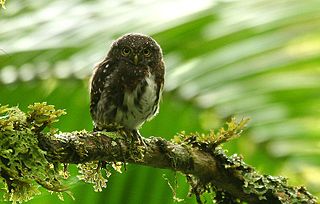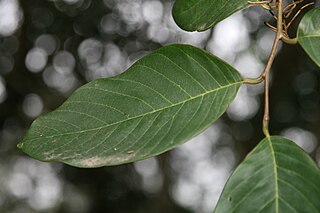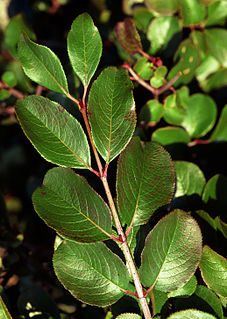
Viburnum prunifolium is a species of Viburnum native to eastern North America, from Connecticut west to eastern Kansas, and south to Alabama and Texas.

The Costa Rican pygmy owl is a species of owl in the family Strigidae found in the Talamancan montane forests of Costa Rica and western Panama.
Cassine viburnifolia is a mangrove plant of tropical Asia in the staff vine family Celastraceae. The specific epithet viburnifolia refers to how the plant's leaves resemble those of the genus Viburnum.
Helicia albiflora is a species of plant in the family Proteaceae. It is endemic to Papua New Guinea. It is threatened by habitat loss.
Helicia amplifolia is a species of plant in the family Proteaceae. It is endemic to Papua New Guinea. It is threatened by habitat loss.
Helicia latifolia is a species of plant in the family Proteaceae. It is endemic to Papua New Guinea. It is threatened by habitat loss.
Helicia neglecta is a species of plant in the family Proteaceae. It is endemic to Papua New Guinea. It is threatened by habitat loss.
Heliciopsis whitmorei is a species of plant in the family Proteaceae. It is a tree endemic to Peninsular Malaysia. It is threatened by habitat loss.
Viburnum arboreum is a species of plant in the Adoxaceae family. It is endemic to Jamaica.
Viburnum divaricatum is a species of plant in the Adoxaceae family. It is endemic to Ecuador. Its natural habitat is subtropical or tropical moist montane forests. It is threatened by habitat loss.
Viburnum hondurense is a species of plant in the Adoxaceae family. It is endemic to Honduras.

Viburnum maculatum is a species of plant in the family Adoxaceae. It is found in Montenegro on Lovćen and Orjen mountains, as well as in parts of Bosnia and Herzegovina. This plant is a xerophyte, and grows on karst mountain terrains.
Viburnum molinae is a species of plant in the Adoxaceae family. It is endemic to Honduras.
Viburnum mortonianum is a species of plant in the Adoxaceae family. It is found in El Salvador and Guatemala.

Viburnum stellato-tomentosum is a species of plant in the Adoxaceae family. It is found in Costa Rica and Panama. It is threatened by habitat loss.
Viburnum subpubescens is a species of plant in the Adoxaceae family. It is endemic to Honduras.
Viburnum tridentatum is a species of plant in the Adoxaceae family. It is endemic to Peru.

Viburnum nudum is a deciduous shrub in the genus Viburnum within the muskroot family, Adoxaceae.

Viburnum rufidulum, also known as the rusty blackhaw, blue haw, rusty nanny-berry, or southern black haw, is a flowering species of shrub or small tree that is common in parts of the Eastern and Central United States. It produces attractive flowers and fall foliage, as well as fruits that are popular with some species of bird.

Viburnum treleasei is a species of Viburnum endemic to the Azores. It inhabits natural forests of Juniperus brevifolia, Laurus azorica and Ilex perado, Erica azorica, in sloping areas. Generally at altitudes above 200 m (660 ft). It is present in eight of the nine islands.








